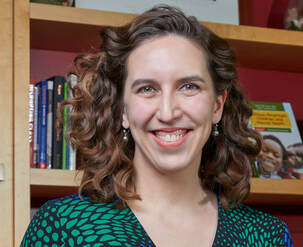|
Welcome to the first BIBA Blog that highlights and reviews operas by Black composers, which are full of such richness and breadth! These posts examine the many ways that composers from the African diaspora have used music and drama to tell urgent and necessary stories of love, history, family, and social justice, as well as operas that celebrate or comment upon various aspects of life, the past, and more, with tones ranging from serious to light . In an art form where racism is both deeply and historically ingrained, blackface and yellowface somehow remain hotly debated, and contemporary artists of color are reclaiming the narrative online, the beauty and power of operas by Black composers are part of a necessary operatic revolution.
WE SHALL NOT BE MOVED, by Daniel Bernard Roumain (DBR) We Shall Not Be Moved came together through the collaboration of three powerhouse artists -- composer Daniel Bernard Roumain, librettist Marc Bamuthi Joseph, and director/choreographer/dramaturg Bill T. Jones, commissioned by Opera Philadelphia. Since we want to save space to talk about the opera itself, these bios are brief, but we encourage you to learn more about each of them -- additional links are included below! The Composer: Daniel Bernard Roumain Daniel Bernard Roumain, often referred to by his initials DBR, is a composer, violinist, and educator, whose artistic works defy categorization. DBR is well-known for blending classical, hip hop, R&B, gospel, and electronic music styles in his compositions, as well as for his wide-ranging collaborations with artists such as Philip Glass, DJ Spooky, and Lady Gaga. His Haitian-American heritage and identity as a Black man also strongly influence his artistic work, themes, and aesthetic. DBR is currently on the faculty of Arizona State University and serves in a number of leadership positions in the classical music field, including board positions with the League of American Orchestras, Association of Performing Arts Presenters and Creative Capital, and the advisory committee of the Sphinx Organization. The Librettist: Marc Bamuthi Joseph A spoken word poet, dancer, director, playwright, and educator, Marc Bamuthi Joseph brings issues of social justice and community building to the forefront through his artistic output, as well as his administrative and consultancy work around the country. Born in New York City to immigrants from Haiti, Mr. Joseph made his Broadway debut at the age of 10, and has become a transformative contemporary leader in the arts, education, social impact, and creative expression fields. He is a 2017 TED Global Fellow, an inaugural recipient of the Guggenheim Social Practice initiative, and an honoree of the United States Artists Rockefeller Fellowship, and currently serves as Vice President and Artistic Director of Social Impact at the John F. Kennedy Center for the Performing Arts. He has collaborated with DBR three times for the projects Blackbird, Fly (2016), We Shall Not Be Moved (2017), and The Just and the Blind (2019). The Director: Bill T. Jones Bill T. Jones is a leading contemporary American choreographer and director whose career in theater, dance, opera and more spans decades. One of the most lauded artists of our time, Mr. Jones’s many honors and awards include the National Medal of Arts, a Kennedy Center Honor, Tony Awards, the Dorothy & Lillian Gish Prize, and a MacArthur “Genius” Grant Fellowship. He is a co-founder of the Bill T. Jones/Arnie Zane Dance Company, and the Artistic Director of New York Live Arts. In addition to the dozens of influential works that he has choreographed and co-choreographed for his own dance company and many others, Mr. Jones is also known for his work on the musicals The Seven, Spring Awakening, and Fela!. History & Context: The MOVE organization It’s difficult to fully appreciate We Shall Not Be Moved without at least a basic understanding of the bombing of the MOVE organization -- and hopefully, you’ll be moved to further deepen your understanding of the events, people, and structural racism that led the Philadelphia police to bomb its own citizens in 1985. MOVE is a Black liberation group (still in existence today) that was founded in 1972 by John Africa, born Vincent Leaphart, a West Philadelphia native and Korean War veteran. Its members lived in communal settings and embraced anti-government, anti-technology, Black power, and animal rights ideals. They spoke out about police brutality and environmentalism, fusing influences from the Black Panther Party and 1960s hippie culture. MOVE staged public demonstrations at zoos, stores, and rallies, and while many supported their principles, their methods and lifestyle were decried by others, including some fellow Black residents in Philadelphia. In 1978, a tense confrontation with police following an eviction order resulted in the death of one police officer and several other injuries. Nine members of MOVE were convicted and given life sentences. The organization relocated in 1981 to 6221 Osage Avenue, in a middle-class, largely African-American neighborhood. Neighbors made public complaints for years about trash around MOVE’s row house and loud political messages delivered via bullhorn. Finally, Mayor Wilson Goode, the city’s first African-American mayor, gave the order to empty the house and arrest four of the occupants on various weapons, parole, and terrorism charges. Nearby residents were evacuated and on the morning of Monday, May 13, 1985, police moved in on the MOVE home, where eight adults and five children were housed. The standoff between the police and MOVE escalated throughout the day. Water and electricity were shut off to the building. There was an armed standoff, then a shootout. That evening, the city of Philadelphia dropped a satchel bomb of Tovex and C-4 explosives on the home, killing eleven people, including five children as well as John Africa, MOVE’s founder. A fire began to spread to adjacent houses. Police Commissioner Gregore Sambor, who had given the bombing order, held back the fire department, and by the end of the night, 61 homes had burned to the ground, leaving 250 residents homeless. The staggering racism, distrust and cavalier police brutality that led to the bombing of MOVE reverberated throughout the city for decades to come. No one was ever charged or held publicly accountable for the attack, and the city of Philadelphia has still not formally apologized, despite recent activism to increase public awareness and to push for restorative justice. The destroyed homes were shoddily rebuilt, and residents moved back to the neighborhood in 1986. But by the early 2000s, the city bought out most of the crumbling buildings and left them vacant, ghostly reminders of a violent past and the unjust present. This is where we find ourselves in the opera We Shall Not Be Moved. We Shall Not Be Moved: The Basic Plot Please refer to Opera Philadelphia’s fantastic full synopsis for plot details -- this is just a taste to help orient you for our discussion! On the streets of Philadelphia, five teenagers -- John Henry, John Blue, John Little, John Mack and Un/Sung -- are on the run after a violent altercation. This chosen family finds refuge in an abandoned building, which is the home of the MOVE organization and site of the 1985 bombing. They begin receiving messages from the spirits of MOVE, referred to as the OGs, who comfort and sustain them. Glenda, a police officer who was born in North Philly and now patrols West Philly, finds them and suspects them of truancy and loitering. She moves to pick them up, but their confrontation explodes and Glenda shoots John Henry, wounding him. The other teens manage to take her gun, holding her hostage. As John Henry’s condition worsens, the teens try to determine their next move. Finally, they tell Glenda the full story of why they are on the run, hoping to bargain for her silence with their own. Glenda, however, realizes that the other teenager whom John Blue shot and killed during the earlier fight was her brother, Manny, and refuses to comply. Increasingly desperate, the teens debate further violence. Un/Sung steps up and offers to take on the task, ordering the others to leave. Un/Sung takes possession of the gun and faces off with Glenda a final time, their confrontation escalating in a blackout. When the lights come back, Glenda recounts her simplified version of the events that ensued, though what is seen onstage is more complex. Opera Philadelphia: Digital Festival O performance Available online through August 31, 2020 There may not be an opera more urgent for our country’s current movement against racism, police brutality, and white supremacy than We Shall Not Be Moved. Inspired in equal parts by the historical reality of state violence against Black bodies and by the present lived experience of Philly youth confronting inequity and injustice present in their own lives, this opera is a deeply emotional story that challenges us, as viewers, to imagine a place where, in the words of Un/Sung, “More than one kind of thing can be true. That’s America too.” All of the characters in We Shall Not Be Moved are complex and sympathetic figures in different ways. Un/Sung, who expresses herself primarily in spoken word, often serves as the narrator of the opera; her brilliance and fierce loyalty to her brothers shines through her words, wise beyond her years, frustrated and stymied by failing schools, poverty, and a world that sees her as worthless. John Mack is driven by his faith and goodness, John Little is a white boy who identifies with his Black chosen family, John Henry displays both toughness and vulnerability even as he lies bleeding, and John Blue is a transgender boy (voiced by a countertenor, though it would be fantastic to see and hear a trans singer in that role -- casting directors, please take note!), the “brother most likely to steal your things and cut you for good measure,” according to the Opera Phil student study guide. In the following clip, Un/Sung talks about the deep bond of this chosen family, then all of them share their stories and histories, displaying the cast’s incredible skills spanning spoken word, gospel, R&B, and of course, classical music styles. Watch through 16:55.
Glenda, likewise, is a layered portrait of a Latina who seems to identify more with her fellow brothers in blue than with her estranged family. She believes in the work that she does, its value and dignity, and is a sympathetic person who also faced difficult circumstances, yet managed to build herself a successful life -- but at what cost? Watch from 18:25 to 21:50 to learn more about Glenda, the “ghetto flower picked and planted by the law.”
The opera is moving and provocative throughout, but the final confrontation between Un/Sung and Glenda is truly where these themes, questions, challenges and protests come together in an explosive climax. These two women -- although one is still a teenager, not yet fully grown -- are embodiments of divergent choices in a system that is stacked against them. One chose the path of conformity by joining the police force, “a well-funded gang” as Un/Sung angrily says, believing that the system of law and order would give her a foothold to a better life. The other is trying to create a life for herself and her brothers outside of this paradigm, a "Harriet Tubman"-like figure seeking an Underground Railroad that will lead to a freedom that they still can’t quite fully imagine. Critiques of police brutality, bias, the meaning of freedom -- it’s all here in We Shall Not Be Moved, echoing our national conversation and adding to the growing crescendo of protests and activism, thanks to the dedication and work of Black Lives Matter and anti-racist allies.
I want to leave you with this incredible scene from Act II, as John Blue, John Little and John Mack share the self-affirmation that they have learned from their spiritual guides, the OGs. Joyous, lyrical, insistent and transcendent, this is a spiritual for our time: “Love is the only word sweeter than Black.”
Additional readings and references:

Lacey Upton is an educator who specializes in the arts, out-of-school time settings, and community engagement. She began her career in opera at the Metropolitan Opera Guild in NYC and spent five years at Boston Lyric Opera as the Director of Community Engagement. She recently earned her Ed.M. from the Harvard Graduate School of Education and currently works in youth development with middle and high school students.
Photo credit: Esso Studios
1 Comment
Mike Bolton
7/28/2020 12:27:53 pm
Hi Lacey,
Reply
Leave a Reply. |
Details
Writings, musings, photos, links, and videos about Black Artistry of ALL varieties!
Feel free to drop a comment or suggestion for posts! Archives
May 2024
|
Member Login
Black concert series and educational programs in Boston and beyond

 RSS Feed
RSS Feed










